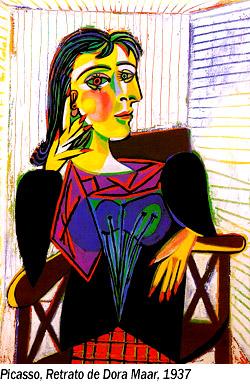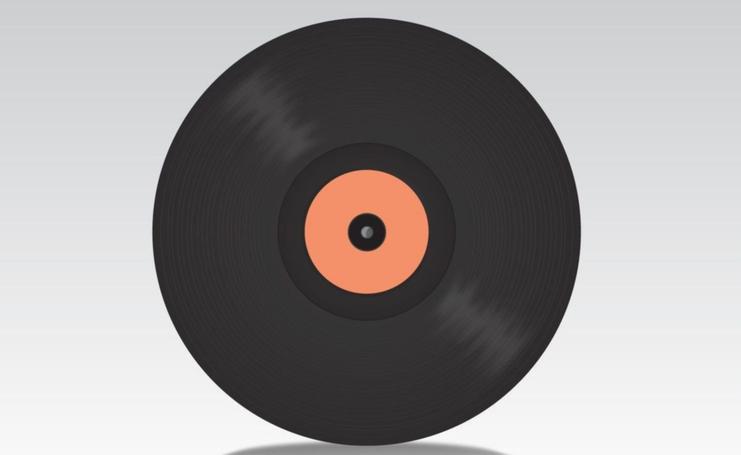(201) Apostasy –4. The ugliness of modern art without Christ
The aesthetics of ugliness is the characteristic feature of the world without Christ. The same spirit that in the West rejects God and his Christ, is the one that disrupts social and political life, breaks up families, extremely reduces the birth rate, it empties philosophy of all truth, despises cultural tradition on principle, dehumanizes peoples, and logically, degrades all arts, sinking them into ugliness. It is the same downward impulse. It all goes together.
In our time, no doubt, there have been and are "modern" artists who, as in the past, continue to produce beautiful works of art, certainly in new forms. Anyone today, moderately cultivated in art, recognizes the great beauty that, during the last hundred years, there is in a sculpture by Rodin, in "The Rite of Spring" by Strawinsky, in an urban landscape by Antonio López or in a building like Frank Ghery's Guggenheim in Bilbao. But these are works of art that have developed in new, sometimes very new ways, the aesthetic tradition of the West, which the Christian nations made flourish to the fullest in all the arts.
But what today is usually called modern art is congenitally ugly. Starting from the same false, bad and ugly spirit, artists extend to all forms of art an ugliness, in a certain conscious and voluntary way, which at no time in its history has affected the arts of humanity to a similar degree. And it is necessary to recognize that the aesthetic empire of ugliness has occurred precisely when the most educated nations have reached a generalized apostasy from the Christian faith. It is normal that this has happened: corruptio optimi pessima.
Could it be that we don't understand the real beauty of modern art, and that's why we don't appreciate it?
The common people, those who foolishly fear being "backward", force themselves to admire works they do not understand. He other times he pretends to admire them, although he rarely acquires them. And on some occasions, even when he is free from the world, he gets to express his true feeling: "this is a scam." In general –let us think, for example, of cacophonous concerts of modern music, insulting ultramodern exhibitions of painting and sculpture, or of certain absolutely unintelligible poetic works–, the people oblivious to aesthetic pedantry abhor modern art which, wanting to free itself from all reference to nature or to the aesthetic languages of tradition, tries to assert itself in an arbitrary solipsism, starting from the self of the author himself only, that is, starting from scratch. In any case, the humble people do not usually dare to express their thoughts in public.
Intellectuals, for the most part, admire modern art, at least in word, because no social class worships today's art more than they do. There is someone who knows his truth, that is, his falsehood, but does not dare to confess it, as is the primary duty of the intellectual. And "he does not confess it, because he is afraid of being excluded from the synagogue" (Jn 12:42). In any case, as is logical, it is precisely in the most self-confident, prestigious guild of intellectuals that criticism and rebellion against the invasion of ugliness in painting or architecture, in poetry, theater or music, and in so many other fields.
Perhaps the expiration date is near for ugly modern artists, not only because of their distance from the people, but also because of the fierce denunciation of some intellectuals. We already know that Beethoven and other musicians were energetically disapproved of him at the beginning, or that Van Gogh barely managed to sell a single painting in his life; and that like them, many other artists, who were not appreciated in their time, are today a glorious patrimony of humanity. And knowing it forces us to treat these issues with special caution. But it does not silence us. In fact, more and more voices, overcoming powerful constraints of the world, dare to denounce the falsehood and ugliness – they go together – of current art, facing excommunication from the widely dominant progressive circles.
Also the "dealers", the sellers of works of art, and the galleries collaborate, in complicity with the progressive media, so that the enormous fraud of modern art continues indefinitely, which allows them to achieve incredible prices for works that they are worth nothing. But, nevertheless, it is necessary to recognize that, even more than these conditions, the inexplicable persistence and appreciation of modern art is influenced by the fact that it really is "an expression of our current world." That's true.
What is the mysterious root cause of the ugliness of modern art? Without a doubt, the rejection of God and of his Christ of him. "He is the image of the invisible God, the firstborn of all creation, for in him all things in heaven and on earth were created" (Col 1:15-16). So the problem is not so mysterious, at least for believers, the children of light.

The professor of aesthetics Pedro Azara needed great lucidity and not a little daring to write the book On the ugliness of modern art (Anagrama, Barcelona 1990). We summarize his thesis in two. 1st- «Never as in the 20th century had ugliness in art proliferated so much. It manifests itself in all fields. It adopts the most varied and surprising forms», to the point that it can be affirmed that «ugliness is consubstantial to modernity» (pgs. 13, 33). And 2nd - This ugliness must be explained above all in terms of irreligiousness. Modern artists, says Azara, emancipating themselves from the gods, even more, "as revenge" more or less consciously against them, trample on natural forms, and claiming to be like God, affirm over the world a divine power, without any limit (14 -16). Furthermore, they demand, although they rarely succeed, that the people accompany them on their lost adventure; Indeed, "the art of the 20th century is an art of fanatics who seek to impose it, discrediting the art of those who are not faithful to the new religion of modern art" (190).
Truth, goodness and beauty demand and make each other possible («verum, bonum et pulchrum convertuntur»). The miracle of perfect beauty cannot occur if it is not linked to truth and goodness. A poem that exhorts nationalist racism, even if it has partial successes of great beauty, cannot have depth or greatness. A dance like Salome's, imbued with evil seduction and homicidal intent, cannot be perfectly beautiful. It is impossible for that poem and that dance to have great beauty because they carry within themselves a perversion of the true human condition, a falsification of the truth, and an offense against the good. José Rivera Ramírez (+1991) left very valuable writings on this and other issues, collected in La belleza y la verdad (Fund. José Rivera, Toledo 2007).
In this sense, the Franco-Russian writer Andrei Markine, who a few years ago received the Goncourt and Médicis prizes, declared in 1997: «there are no great novels in the West because today man forgets the great questions, because we have of twenty types of yogurt so as not to have to talk about God or death. But if you don't talk about it, if there is no anguish in the face of the unknown, there is no philosophy or great artistic creation possible».
Atheism produces a spiritually ugly man, in himself dark, contradictory and trivial, who cannot produce profoundly beautiful works. A selfish and bitter artist, for example, who prefers evil to good, lies to truth, chaos to harmonious order, who does not know how to forgive, who considers life absurd, who is desperate and who will possibly end up on drugs or suicide, is incapable of producing a work of art full of luminosity and harmony, full of strength and joy, depth and transcendence. In the same way, a culture far removed from truth and goodness, that is, from God, becomes incapable of producing truly beautiful works. For this reason, the art of the de-Christianized world, insofar as it seeks to achieve itself by rejecting God, and specifically, without Christ, is a priori condemned to ugliness, as we verify a posteriori.
***
Without paying much attention to the order and selection, I am going to give a few examples of ugly modern art, which allow us to verify these aesthetic diagnoses that I have exposed.
John Milton Cage Jr. (1912-1992) is considered one of the leading American composers of the 20th century, a pioneer especially in random and electronic music. Musical theorist, poet, painter, seduced by Zen and the arts of the East, philosopher (!), he also contributed to the development of modern dance through his association with the choreographer Merce Cunningham, who was his sentimental partner for most of his life. We can get an idea of Cage's art by listening to his Piano Concerto (10'), or by listening to his composition 42' 33'', which consists of three movements that are performed without playing a single note. It is not necessary, of course, to listen to them in their entirety, but I warn you that hearing them, which will only be a vision in the second case, degrades Purgatory in order.
If customs are your thing go check out these legends. They have supported me from day 1 and know how to have a good… https://t.co/HKDUd6ZNJP
— Holty_ Sat Jul 24 04:52:35 +0000 2021
Ramón Lazcano (San Sebastián, 1968-) is a Spanish composer living in Paris. I will not bring any of his sound works here, but I will put him as an example of the aesthetic theorization with which modern artists very often try (?) to explain the mystery of his works. In the program distributed at the "world premiere" of his work Mugarri (approx. 13') (Pamplona, 2010) he writes:
This irrational prose, more than explaining the work, confirms our diagnosis of its falsehood. It unites, without any cerebral short-circuit, the experimental space and the "fragile and connoted" matter, the precise and the blurred, the hidden and the unveiled, what is recognized and ignored, while constantly interrogating a time associated with the evolution of a non-preset way. The text cannot but remind us of the "philosophical" prose of the Kristeva, which I cited as an example at the end of my previous article. If you don't know what you're saying when speaking, the same thing probably happens to you in your musical language. Modern irrationality unites philosophers and artists: one and the other come to speak the same language, sometimes consciously insignificant.
I also note that terms like "world premiere" or "world premiere" for modern music composers often mean that this is the first time the work has been performed, and probably the last. The works of the most notable modern composers are rarely included in the programming of concerts or radio broadcasts, because the listeners protest. And when they are not notable, but of a secondary level, their works are almost never performed again after their premiere: the "world premiere" is total and unique. In 2011, a study of a survey carried out on 11,700 concerts given around the world informed us that the most performed authors had been Mozart, Bach, Brahms, Haydn, Schubert, Tchaikovsky and Mahler. At an enormous distance were the most notable modern musicians, Schönberg, Webern, Berg, Berio, Ligeti, etc.
And the thing is that the vast majority of music fans don't like modern music. Mugarri's audition, as a music critic wrote the next day, garnered "polite applause," which could well be translated as "charitable applause." Ultra-modern music has been playing for a hundred years, and music lovers still don't like it. But this, it seems, does not matter at all. The most prestigious Spanish composer of this music, Luis de Pablo (Bilbao, 1930-), declared in 2011: «It should not worry that the public does not like contemporary music. It will change»... They are inaccessible to discouragement.
Poets. There is a mini-anthology, with a couple of unknown current poets:
And I add two examples from well-known authors. The second of them is the author of excellent poems, which are not so excellent when, giving in to fashion, he turns to extreme irrationalism. But even in those cases its poetic quality is noticeable.
Other poets, notable or unknown, have already accustomed us to the ineffable and indecipherable, better yet, to the absurd: "blue elephants graze in the pupils of your eyes"... And the people, as has happened with music modern, has moved a long way from poetry, because it does not understand it, nor does it have to understand it: too often it is absurd. Eugenio d'Ors said in the Botanical Garden that "madness is insipid." I think, however, and I don't know if I'm wrong, that today of all the arts it is modern poetry that most often escapes the horrors of the world without Christ. Not infrequently he tells the truth.
Ugliness in modern art manifests itself in very diverse tendencies. Although sometimes it goes towards the enormous and the variegated, it also leans, perhaps more frequently, towards a minimalist and poor, monotonous and absurd ascetic expression: the poem that gathers a few almost silent words, of an almost total opacity; the piece of music that prolongs a single, sharp, penetrating note for several minutes, with minimal emission variations; the formidable building that could have a shoebox as a model; the painting barely smudged, crossed by a single energetic aggressive stripe – great! – and nothing more. We can see what I mean in the following example.
Mark Rothko (Latvia 1903-New York 1970), a very notable painter, produced works that can be seen in the most important museums in the world, such as the Guggenheim in Bilbao, the Whitney Museum of American Art, the Phillips Collection in Washington. After some approximations towards abstract expressionism and surrealism, from 1947 he focused his production on large rectangular paintings, generally vertical, that alternate fine layers of color, leaving the edges blurred. His 1954 exhibition at the Art Institute of Chicago was the main manifestation of his pictorial style, which he would cultivate until his death. That 1954 exhibition included the large painting No. 1, 1954, which was recently auctioned at Sotheby's and acquired at the price of 59 million euros.
Artur Barrio (Porto, 1945-). Copy from a press agency (IX-2011). "Deliberately incorrect. Radically visceral. This is the art of the Brazilian Artur Barrio, who has given him the Velázquez prize, the Cervantes [prize] for Hispanic plastic arts, endowed with 125,000 euros and the highest institutional rank of all those awarded in Spain.
They tell an anecdote that happened in Paris in the most fervent years of abstract or symbolist or surrealist art; I don't remember. A student, helped by some friends, managed to paint an oil painting with the help of a donkey, to whose tail they successively tied brushes with different colors. Bringing the donkey closer to the canvas, he did what he could on it. And the painting was admitted to a group exhibition of modern art, getting critics, let's say, normal. A similar experience was made this year, managing to exhibit clandestinely at the famous modern art fair organized annually by the ARCO gallery (Madrid) a "picture" painted by the slapping of several 2 and 3 year old children. These anecdotes help to estimate that in modern art anything goes, as in philosophy.
Pablo Ruiz Picasso (Málaga, 1881-Mougins, France, 1973) painted in several phases of different styles, indicating himself as a promoter of cubism. He painted more than two thousand works, distributed in museums and collections around the world. In a recent article Picasso's Bitter Confession, alleged statements made by Picasso to the magazine of L'Association Pupulaire des Amis de Musées ("Le Musé vivant" nº 17-18, 1963) were reproduced. But they are apocryphal. As Santiago warns in a commentary to my article (1.20.12-5:08 pm), it is a text by Giovanni Papini in his Black Book (1952), where in the chapter Visit to Picasso (or the end of art) fakes an interview with Picasso himself. Although the confession is not authentic, it is true that on many occasions the artist expressed himself in similar terms, especially when he spoke about beauty as something alien to his work: «I am horrified by people who talk about beauty. What is beauty? What needs to be talked about is paint problems. Painting is nothing more than research and experimentation. I never paint a picture as a work of art. All of them are experiments» (Liberman, Picasso, Vogue, 11-1-1956). The Italian saying se non è vero, è ben trovato is fulfilled here. Let's see the confessions of the pseudo-Picasso::
May God forgive all those responsible for the immense fraud of modern art, who have humiliated the humanity of our time in a world without Christ. Giovanni Papini said that "the smile is from the angel, the laughter from man, and the laughter from the devil". The devil, the Enemy of the human race, is the father of lies –of all lies, including this one–, and if he were joking, he would laugh at so many apostate nations, today prostrate before the monstrosities of modern art, that offer before them the incense of many millions of euros reduced to ashes.
May God also forgive all those leading Catholics –teachers and professors, writers and politicians, Bishops and rectors of parishes and sanctuaries– who, turning their backs on the various traditions of Christian art, thus disregarding the truth, goodness and beauty, have not denounced the congenital ugliness of agnostic and Christless art, and have worshiped its horrendous works, deceiving others and, first, themselves. As long as they are worldly, children of their time, they go through anything.
José María Iraburu, priest


